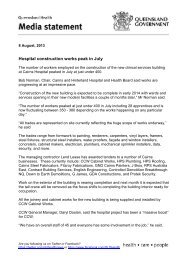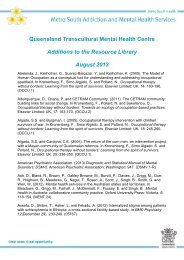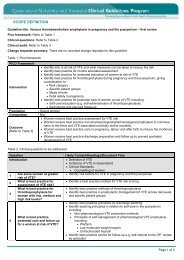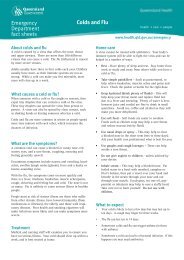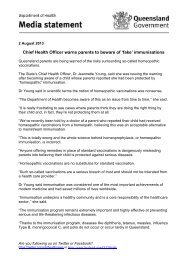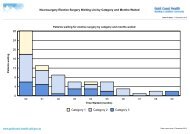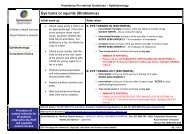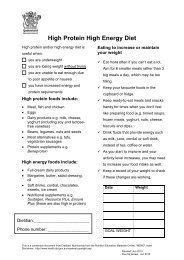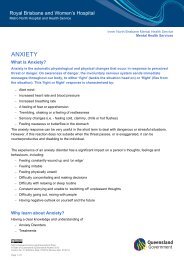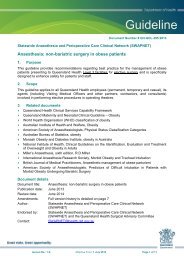Home Safety Checklist - Queensland Health
Home Safety Checklist - Queensland Health
Home Safety Checklist - Queensland Health
Create successful ePaper yourself
Turn your PDF publications into a flip-book with our unique Google optimized e-Paper software.
Did you know that in <strong>Queensland</strong>,<br />
injury is the leading cause of childhood<br />
death? 1<br />
Did you know that the number of child<br />
deaths caused by injury in <strong>Queensland</strong> is<br />
one of the highest in Australia? 2<br />
The majority of these children are aged<br />
0-4 y ears and they are usually injured in<br />
the family home or yard. 3 Drowning is the<br />
most common cause of child injury death<br />
and most children drown in backyard<br />
swimming pools. 4 5 The major injuries that<br />
•<br />
•<br />
How you can be an agent<br />
of change in your home<br />
By choosing to undertake this simple<br />
home safety audit you’re on your way<br />
to identifying and isolating many<br />
common safety hazards in and around<br />
your home.<br />
the importance of<br />
your mission<br />
happen to <strong>Queensland</strong> children requiring<br />
Emergency Department treatment or<br />
admission to hospital are near drownings,<br />
falls, poisonings, scalds, burns, driveway<br />
run-overs and dog bites. 6<br />
How to use this checklist:<br />
Did you know child injuries can be<br />
prevented; they are not accidents, chance<br />
events or an inevitable part of growing up?<br />
By making changes in your home, buying<br />
safer products and providing effective<br />
adult supervision you can reduce injuries<br />
to children in <strong>Queensland</strong> homes.<br />
T ake<br />
it<br />
and<br />
a pen<br />
with<br />
you,<br />
walk<br />
from<br />
room<br />
to<br />
room<br />
in<br />
your<br />
home<br />
and<br />
yard.<br />
As you go, answer the questions. Remember to look at your home from the eye<br />
level of children.<br />
Y ou<br />
may<br />
find<br />
it<br />
easier<br />
to<br />
look<br />
at<br />
one<br />
room<br />
or<br />
area<br />
at<br />
a time.<br />
• F or<br />
each<br />
question,<br />
the<br />
symbol<br />
used<br />
highlights<br />
an<br />
injury<br />
risk.<br />
You<br />
can<br />
use<br />
the<br />
symbols<br />
to work on one injury issue at a time such as scalds or falls.<br />
1
For each question answer YES or NO.<br />
If you don’t know the answer, mark NO<br />
and follow the advice given anyway.<br />
If the question doesn’t apply to your<br />
home (for example, if you don’t own a<br />
swimming pool), simply move on to the<br />
next question.<br />
If you answer NO to any question (or<br />
you’re not sure), then you have found a<br />
likely danger. Please follow up with the<br />
practical ideas in this <strong>Checklist</strong> to improve<br />
•<br />
A lways<br />
keeping<br />
hot<br />
drinks<br />
out<br />
of<br />
reach.<br />
• Locking medications and poisons up high.<br />
• Blocking access to the driveway.<br />
• Keeping the pool securely fenced and the<br />
gate latched.<br />
• Installing smoke alarms, hot water tempering<br />
devices and an electrical safety switch.<br />
1. Australian Bureau of Statistics. Australian Social Trends 1996.<br />
<strong>Health</strong> – causes of death: accidental death of children.<br />
2. ibid<br />
3. Q ueensland<br />
Injury<br />
Surveillance<br />
Unit.<br />
Injuries in the<br />
<strong>Home</strong> – Children. Injury Bulletin No. 66 June 2001<br />
4. Q ueensland<br />
Injury<br />
Surveillance<br />
Unit.<br />
Water related Injury<br />
in <strong>Queensland</strong> Injury Bulletin No. 85 December 2004<br />
2<br />
a child’s safety. Don’t forget, even after<br />
you have made any changes, ongoing<br />
adult supervision is still critical to keep<br />
children safe.<br />
It is recommended that you re-do this<br />
<strong>Checklist</strong> at each of your children’s birthdays<br />
so you can keep track of dangers and<br />
prevent injuries as your children continue<br />
to grow and explore.<br />
<strong>Home</strong> safety is mission possible. you can<br />
act now by:<br />
5. Q ueensland<br />
Injury<br />
Surveillance<br />
Unit.<br />
Toddler Drowning<br />
in <strong>Queensland</strong> Injury Bulletin No 62 November 2000<br />
6. <strong>Queensland</strong> Injury Surveillance Unit. Top 10 Preventable<br />
injuries for <strong>Queensland</strong> children under 5 years old<br />
accessed on 02 January, 2007 at http://www.qisu.org.au/<br />
modcore/InjuryTopics/backend/images_uploaded/Top10.pdf
Fire Crushing injury<br />
s<br />
p<br />
r<br />
a<br />
h<br />
S<br />
s<br />
d<br />
l<br />
a<br />
c<br />
S<br />
s<br />
l<br />
l<br />
i<br />
k<br />
s<br />
R<br />
P<br />
C<br />
k<br />
c<br />
o<br />
h<br />
s<br />
l<br />
a<br />
c<br />
i<br />
r<br />
t<br />
c<br />
e<br />
l<br />
E<br />
r<br />
e<br />
g<br />
n<br />
a<br />
d<br />
V<br />
U<br />
s<br />
l<br />
l<br />
a<br />
F<br />
t<br />
n<br />
e<br />
m<br />
p<br />
i<br />
u<br />
q<br />
e<br />
y<br />
a<br />
l<br />
P<br />
g<br />
n<br />
i<br />
n<br />
w<br />
o<br />
r<br />
D<br />
Poisons<br />
On the road/Out and<br />
about<br />
y<br />
t<br />
e<br />
f<br />
a<br />
s<br />
e<br />
l<br />
c<br />
y<br />
c<br />
i<br />
B<br />
d<br />
r<br />
a<br />
z<br />
a<br />
h<br />
g<br />
n<br />
i<br />
k<br />
o<br />
h<br />
C<br />
y<br />
c<br />
n<br />
e<br />
g<br />
r<br />
e<br />
m<br />
e<br />
l<br />
a<br />
r<br />
e<br />
n<br />
e<br />
G<br />
y<br />
t<br />
i<br />
r<br />
u<br />
c<br />
e<br />
S<br />
s<br />
d<br />
r<br />
a<br />
d<br />
n<br />
a<br />
t<br />
S<br />
n<br />
a<br />
i<br />
l<br />
a<br />
r<br />
t<br />
s<br />
u<br />
A<br />
s<br />
r<br />
e<br />
v<br />
o<br />
-<br />
n<br />
u<br />
r<br />
y<br />
a<br />
w<br />
e<br />
v<br />
i<br />
r<br />
D<br />
legend<br />
3
<strong>Home</strong> <strong>Safety</strong> is Mission Possible<br />
YOUR MISSION IS TO MAKE YOUR HOME SAFE! YES NO<br />
GENERAL<br />
D o you<br />
have<br />
working<br />
smok<br />
e<br />
alarms installed?<br />
If you answered NO, purchase a smoke alarm/s from your local hardware, variety or department store,<br />
check for an Australian Standards or Scientifi c Services Laboratory mark, install outside sleeping areas<br />
and on the ceilings of living areas.<br />
Is your hot water system set at 50 0 C?<br />
If you answered NO, contact a licensed plumber who can install a tempering valve. <strong>Queensland</strong> laws<br />
require that all new hot water systems be tempered to 50 0 C for all sanitary fi xtures i.e. baths, basins<br />
and showers.<br />
Is your home fi tted with a working electrical<br />
safety switch?<br />
If you answered NO and your house was built before 1992, it may not have an electrical safety switch.<br />
Contact a licensed electrician immediately.<br />
Are electrical cords out of sight and reach<br />
of children?<br />
If you answered NO, place electrical cords behind furniture, secure along wall edges, and whenever<br />
possible, clear of pathways and out of sight and reach of children.<br />
Are all curtain and blind cords out of reach?<br />
If you answered NO, install a cleat (available from hardware or curtain shops) so you can wind any<br />
curtain/blind cords up and out of reach.<br />
Is all top-heavy furniture such as bookshelves,<br />
ovens, televisions (especially wide screens) and<br />
bird baths, secured to the wall, fl oor or ground?<br />
If you answered NO, as a guide, any furniture units one metre or higher should be secured to prevent<br />
crushing injuries to children. You can secure furniture to a reinforced wall using angle braces available<br />
from most hardware stores.<br />
4
YOUR MISSION IS TO MAKE YOUR HOME SAFE! YES NO<br />
GENERAL<br />
Are there barriers or gates on steps and stairs?<br />
If you answered NO, install safety gates at the top and bottom of all stairs. These gates are available<br />
from baby, hardware and department stores.<br />
Are balcony and deck railings free of climbing<br />
footholds?<br />
If you answered NO, keep patio furniture, toy boxes or potted plants away from the railings to prevent<br />
children using them as a ladder. For existing railings attach plastic garden sheeting or taut shade cloth<br />
to the inside of the railings. If building a new deck/balcony, ensure railings are vertical, about 1200mm<br />
high (about adult hip height), and spaced 50-85mm (about one hand span) apart.<br />
Are there push out security screens or window<br />
guards installed on upper storey windows?<br />
If you answered NO, all upper storey windows should have a restricted opening of 100mm or a window<br />
guard fi tted externally. For fi re safety reasons, these screens or guards should be able to be pushed<br />
out by an adult.<br />
Important tips for in and around your home:<br />
• Test your smoke alarms by pressing the test button on your smoke alarm on the same day<br />
(e.g. April 1 st ) each year. Keep the smoke alarm dust free by cleaning once a month.<br />
• You can check if you have an electrical safety switch by looking at your switchboard/fusebox<br />
for a TEST/RESET button.<br />
• Check the safety switch by pressing the TEST/RESET button. This should automatically trip<br />
the switch to the ‘off’ position. Reset by pushing the switch back to ‘on’. If your safety<br />
switch does not work, contact an electrical contractor immediately.<br />
• Keep all small or sharp objects (such as coins, pins, shaving razors, scissors and knives) out<br />
of sight and reach.<br />
• Make sure all handbags and backpacks (especially visitors’) are out of reach.<br />
• Do not use baby walkers at any time.<br />
• Keep all combustible materials (such as clothes, bed linen, curtains and tea towels) stored<br />
away from heaters and lamps. Do not dry the washing in front of a room heater.<br />
• Even after all these general and specifi c modifi cations are made to your home, there is still<br />
a need for you, as a parent or carer, to provide on-going and effective supervision of any<br />
young child in your home.<br />
5
YOUR MISSION IS TO MAKE YOUR HOME SAFE! YES NO<br />
KITCHEN<br />
Do your electrical appliances have short cords<br />
positioned so they do not dangle over the bench?<br />
If you answered NO, place all electrical appliances towards the back of the kitchen bench, preferably<br />
out of sight and reach of a child. Some newer models of kettles also have a space to wind up the<br />
electrical cord under the kettle base.<br />
Is the kettle out of a child’s reach?<br />
If you answered NO, place the kettle at the back of the bench.<br />
Is the microwave out of a child’s reach?<br />
If you answered NO, place the microwave at adult eye level or at the back of the bench.<br />
Do you have a stove/bench guard or similar barrier<br />
installed in front of the hotplates?<br />
If you answered NO, stove guards can be purchased from a variety of outlets such as Kidsafe House<br />
and some other retail outlets.<br />
Do you store your kitchen poisons (such as<br />
dishwashing powders, cleaners, pesticides,<br />
solvents, medications and vitamins) up high, out<br />
of reach in a locked, child resistant cupboard?<br />
If you answered NO, poisons need to be locked up high and out of reach. Cupboard locks can be<br />
purchased from a variety of outlets such as Kidsafe House, baby shops, hardware stores and local<br />
supermarkets.<br />
6
YOUR MISSION IS TO MAKE YOUR HOME SAFE! YES NO<br />
KITCHEN<br />
Does the high chair have a fi ve-point harness?<br />
If you answered NO, fi ve-point harnesses can be purchased from Kidsafe House or baby shops.<br />
D o you<br />
have<br />
a fire<br />
blanket<br />
or<br />
fire<br />
extinguisher near the kitchen?<br />
If you answered NO, install a fi re blanket and/or fi re extinguisher near the kitchen. These items can be<br />
purchased from some retail outlets or hardware stores. Make sure that they both meet the Australian<br />
Standard (AS 0090).<br />
Important tips for the kitchen:<br />
• Use the back hotplates when cooking on the stove.<br />
• Turn any saucepan and frying pan handles around, out of reach of children.<br />
• Only boil as much water as you need at a time in the kettle.<br />
• Use place mats instead of tablecloths.<br />
• Store plastic bags out of reach and knotted in the middle.<br />
• If you have any medications or vitamins in the kitchen, lock them up high out of sight and<br />
out of reach of children.<br />
• Try to keep young children out of the kitchen when you are using the stove or oven.<br />
• Use the fi ve point harness every time you use the high chair and use the chair in its<br />
lowest level.<br />
• Never transfer any poison from its original container (for example never re-use old soft drink<br />
bottles to store liquid poisons).<br />
7
YOUR MISSION IS TO MAKE YOUR HOME SAFE! YES NO<br />
LIVING AREAS<br />
Are power points free of double adapters?<br />
If you answered NO, use power boards, and if necessary, contact a licensed electrical contractor to<br />
install more power points.<br />
Are there safety guards attached to the wall<br />
around fi replaces, fuel stoves and heaters?<br />
If you answered NO, use safety guards around fi re places and fl oor heaters. <strong>Safety</strong> guards can be<br />
purchased from hardware stores or specialty shops.<br />
A re<br />
glass<br />
doors<br />
made<br />
of<br />
Austra<br />
lian<br />
Standard safety glass?<br />
If you answered NO, homes built before the mid-1970’s may not have safety glass installed. To make<br />
your current windows and doors safer, have a glazier apply a thin sheet of polyester laminate to<br />
one side of the glass panel. When replacing glass, check that new glass meets the recommended<br />
Australian Standards (AS 1288, AS/NZS 2208).<br />
I s your<br />
children’<br />
s night<br />
wear<br />
labelled<br />
as<br />
LOW FIRE DANGER?<br />
If you answered NO, only purchase night wear, jumpsuits and other clothes for your child (sizes 00-14)<br />
which have the low fi re risk danger rating on the tag.<br />
Important tips for living areas:<br />
• Make sure that all hot liquids (including tea, coffee and noodles) are well out of reach.<br />
• Do not carry a child on your hip, or sit a child on your lap while drinking a hot drink, eating<br />
noodles or having soup.<br />
• Place corner cushions on sharp furniture corners such as coffee tables. These cushions are<br />
available from Kidsafe House and baby shops.<br />
• Arrange furniture to allow a clear pathway.<br />
• Make glass doors more visible by putting stickers on the door at your child’s eye level.<br />
• Cover unused power points with safety plugs.<br />
• Avoid double adapters wherever possible and do not “piggy back” adapters on each other.<br />
8
YOUR MISSION IS TO MAKE YOUR HOME SAFE!<br />
LAUNDRY<br />
YES NO<br />
Are laundry cleaners, bleaches and detergents<br />
stored up high, out of reach and sight in a locked,<br />
child resistant cupboard?<br />
If you answered NO, laundry cleaners, bleaches and detergents need to be locked out of sight and<br />
reach. Child resistant cupboard locks can be purchased through a variety of outlets such as Kidsafe<br />
House, hardware stores and nursery outlets.<br />
Important tips for the laundry:<br />
• Empty the lint fi lter in your clothes dryer after each use.<br />
• Make sure you use a tight fi tting and secure lid for all nappy buckets.<br />
• Make sure laundry tubs, buckets and washing machines are empty when not in use.<br />
YOUR MISSION IS TO MAKE YOUR HOME SAFE! YES NO<br />
BATHROOM<br />
Are all medications locked away out of reach?<br />
If you answered NO, store medications up high, out of sight of your child, locked up and out of reach<br />
in a different location. Medications should not be stored in a damp room such as the bathroom.<br />
Do you have slip resistant surfaces in all<br />
wet areas?<br />
If you answered NO, apply non-slip strips to the base of the bath and shower. You can also apply a<br />
non-slip fl oor solution to the tiles, available from tile suppliers and hardware stores.<br />
Important tips for the bathroom:<br />
• Make sure all substances that can poison a child (including shampoos, soaps, mouthwashes,<br />
perfumes, hair dyes, nail polishes and nail polish removers) are kept up high and out of<br />
reach of children in a secure cupboard.<br />
• All children should be closely supervised in the bathroom at all times.<br />
• Do not use devices such as bathing seats or cradles.<br />
• Do not use electrical appliances such as shavers and hair dryers when children are present<br />
in the bathroom and ensure that after use, the appliances are unplugged and stored safely<br />
away from water and the sight and reach of children.<br />
• Try to ensure that wet fl oor surfaces are dried as soon as possible.<br />
9
YOUR MISSION IS TO MAKE YOUR HOME SAFE! YES NO<br />
ADULT’S BEDROOM<br />
Are all medications, (including the oral<br />
contraceptive) stored out of reach of your child?<br />
If you answered NO, do not store medications on the bedside table; it is best to kept all medications<br />
locked away, up high, out of the sight and reach of your child.<br />
Important tips for adult’s bedroom:<br />
• Store eucalyptus and aroma therapy oils, as well as herbal and homoeopathic products out<br />
of reach and out of sight because they can be poisonous for children and pets.<br />
• Do not leave medications on the bedside table. Leave a note to yourself on the bedside<br />
table as a reminder to take your medications.<br />
10
YOUR MISSION IS TO MAKE YOUR HOME SAFE! YES NO<br />
CHILD’S BEDROOM<br />
D oes<br />
your<br />
child’<br />
s cot<br />
Australian Standards?<br />
comply<br />
with<br />
current<br />
If you answered NO, select cots that have a label showing it complies with the Australian Standard<br />
(AS/NZS 2172) and select any portable/folding cots made to the (voluntary) Australian Standard<br />
(AS/NZS 2195:1999).<br />
Is the cot mattress fi rm and fl at?<br />
If you answered NO, and the mattress has dips and is not fi rm, replace.<br />
Does the cot mattress fi t snuggly in the cot?<br />
If you answered NO, and there is a gap between the mattress and cot sides wider than one fi nger<br />
space, purchase a mattress that fi ts snugly in the cot.<br />
A re<br />
the<br />
ends<br />
and<br />
sides<br />
of<br />
any<br />
bunk<br />
bed<br />
fi tted with a safety rail or guard 160mm<br />
(approximately two hand spaces) above<br />
the mattress?<br />
If you answered NO, safety rails can be purchased from bed suppliers. Before buying new bunk beds,<br />
check that the bed has been tested and complies with the relevant Australian Standard (AS/NZS 4220).<br />
Does the mattress fi t snuggly into the bunk bed<br />
frame?<br />
If you answered NO, the mattress needs to fi t into the bed frame with a gap of no more than one<br />
fi nger space.<br />
11
YOUR MISSION IS TO MAKE YOUR HOME SAFE! YES NO<br />
CHILD’S BEDROOM<br />
I s the<br />
bunk<br />
bed<br />
placed<br />
as<br />
clo<br />
bedroom walls?<br />
se<br />
as<br />
poss<br />
ible<br />
to<br />
the<br />
If you answered NO, re-position the bunk bed in the room to prevent gaps between the wall and edge<br />
of the bunk bed.<br />
Does the change table have a waist belt with high sides?<br />
If you answered NO, try changing baby on the fl oor. In future, if you purchase a change table, buy one<br />
that has a waist belt and high sides.<br />
Does the change table have U-shaped foam?<br />
If you answered NO, replace the foam on the change table with U-shaped foam. The sides of the foam<br />
should be 100mm to prevent roll-offs.<br />
Important tips for child’s bedroom:<br />
• Keep any cots, beds and bunk beds away from hazards such as windows, blinds, cords<br />
and fans.<br />
• Store children’s toys where they can reach without climbing.<br />
• Avoid toy boxes with lids.<br />
• Ensure that all toys are not a choking hazard and are appropriate to the children’s<br />
developmental stage and age.<br />
• Make sure that the cot is free from bumpers, pillows and soft toys.<br />
• Keep all items needed for a nappy change within reach of the change table, or else change<br />
the nappy on the fl oor.<br />
• Children develop quickly so make sure that you use the waist belt on the change table from<br />
the very beginning so you both get in the habit.<br />
• Ensure all children who sleep in the top bunk bed are aged over 9 years old.<br />
• Place baby on its back to sleep and do not use a water bed or bean bag for a sleeping baby.<br />
• As a general rule, do not accept second hand nursery furniture which often fails to meet<br />
Australian Standards.<br />
12
YOUR MISSION IS TO MAKE YOUR HOME SAFE! YES NO<br />
GARAGE/SHED<br />
Can the lawnmower, lawn edger and other sharp<br />
tools be securely locked in the garage/shed?<br />
If you answered NO, buy a lock for the shed or garage door, or else install a locked storage area inside<br />
the shed or garage.<br />
Are all chemicals (such as pesticides, paints, car<br />
products, pool chemicals or fl ammable liquids) and<br />
other poisons stored in a secured area out of reach<br />
of children?<br />
If you answered NO, store chemicals out of reach and up high for smaller containers. For larger volumes<br />
of chemicals, store in a locked garage, or in a locked section/cupboard in the shed.<br />
Important tips for the garage/shed:<br />
• Make sure those products that give off vapours and fumes such as petrol, kerosene, paints<br />
or solvents are tightly capped and stored away from any ignition sources.<br />
• Keep all chemicals and poisons in their original containers or approved storage containers<br />
(for example a petrol jerry can).<br />
13
YOUR MISSION IS TO MAKE YOUR HOME SAFE! YES NO<br />
BACKYARD<br />
I f you<br />
have<br />
a swimmi<br />
ng<br />
pool<br />
or<br />
spa,<br />
are<br />
they fully enclosed (on all four sides) by a<br />
fence at least 1.2m high with a self-closing,<br />
self-latching gate?<br />
If you answered NO, your pool or spa fence or gate does not comply with Australian Standards, it is<br />
illegal. Contact your Local Council and pool-fencing contractor immediately.<br />
Is there a clearly visible, laminated<br />
Cardio-Pulmonary Resuscitation (CPR) poster<br />
near the pool/spa?<br />
If you answered NO, install a CPR poster. The <strong>Queensland</strong> Ambulance Service and pool shops have CPR<br />
posters available at a small charge.<br />
Is at least 50% of the pool and play area protected<br />
from the sun’s ultra violet rays by natural shade or<br />
shade structures?<br />
If you answered NO, install a shade cover/shade sails, making sure you observe the manufacturers<br />
installation guidelines and regularly monitor the condition of the structure.<br />
D oes<br />
all<br />
the<br />
backyard<br />
play<br />
equipment<br />
( such<br />
as swings, jungle gyms and trampolines)<br />
comply with current Australian Standards?<br />
If you answered NO, when purchasing play equipment ask if it meets Australian Standards (AS/NZS<br />
4486.1:1997). Purchase a newer style trampoline without springs and with high sides. For older style<br />
trampolines, buy safety pads to cover springs and metal edges, install soft fall material (bark chips or<br />
rubber), 30cm deep and in a two metre wide area all around the trampoline.<br />
14
YOUR MISSION IS TO MAKE YOUR HOME SAFE! YES NO<br />
BACKYARD<br />
Does all play equipment over 500mm tall have soft<br />
fall undersurfaces (e.g. woodchip)?<br />
If you answered NO, install a soft fall material 30cm deep and two metres around slippery slides,<br />
swings, and other high play equipment.<br />
Is the children’s play area(s) separated from the<br />
driveway by a gate or other form of barrier?<br />
If you answered NO, install a fence to keep play areas separate from the road and driveway. If this is<br />
not possible only move the car when children are in the car with you or when you have ensured that<br />
they are under the supervision of another adult.<br />
Important tips for the backyard:<br />
• Regularly check and maintain your pool fence and self-latching gate.<br />
• Remove items such as garden seats, rocks or ladders that could be propped against the pool<br />
fence to allow access to the pool.<br />
• Always supervise children around pets, especially dogs, and particularly when a dog is<br />
sleeping, eating, or caring for puppies.<br />
• Check your children’s play areas for poisonous or irritant plants and fungi (especially after<br />
heavy rain).<br />
• When buying play equipment only purchase equipment that meets your children’s current age<br />
and stage of growth needs.<br />
• Limit your children’s exposur e to UV radiation during the hottest part of the day (10am - 3pm).<br />
Ensure children play indoors or in shaded areas and always remember to Slip on shirts and<br />
shorts, Slop on SPF 30+ sunscreen (20 minutes before sun exposure and reapply every<br />
2 hours), Slap on a broad brim hat and Wrap on some sunglasses.<br />
15
YOUR MISSION IS TO MAKE YOUR HOME SAFE! YES NO<br />
ON THE ROAD/OUT AND ABOUT<br />
H ave<br />
you<br />
instal<br />
led<br />
an<br />
Austra<br />
lian<br />
Standards<br />
approved child restraint or baby capsule?<br />
If you answered NO, look for the Australian Standards symbol (AS/NZS 1754) and date of manufacture<br />
on the base or side of the child restraint/baby capsule. Measure and weigh your child. Check that<br />
the child restraint/baby capsule is appropriate for your child’s height and weight by looking at the<br />
instruction sticker, or in the instruction booklet.<br />
Are there child safety locks installed on the<br />
car doors?<br />
If you answered NO, keep car doors locked.<br />
D oes<br />
your<br />
child<br />
always<br />
sit<br />
in<br />
the<br />
back<br />
seat<br />
in an approved baby capsule, child restraint,<br />
booster seat or harness?<br />
If you answered NO, baby capsules or child restraints are only designed to fi t into the back seat.<br />
Never place a baby capsule or child restraint in the front seat of a car, particulary if it is fi tted with<br />
an air bag .<br />
Does your child wear an Australian Standards<br />
approved safety helmet when riding a tricycle,<br />
scooter or bicycle?<br />
If you answered NO, purchase an Australian Standards (AS 2063) helmet for use every time your child<br />
uses a bike or other toys such as skateboards, scooters, roller blades and in-line skates.<br />
Do you use an Australian Standards<br />
approved pram or stroller fi tted with<br />
a fi ve-point harness?<br />
If you answered NO, purchase prams or strollers that meet the Australian Standard (AS 2088).<br />
16
Important tips for on the road and out and about:<br />
• Protect your children from harmful UV radiation when outdoors or travelling in a vehicle, by<br />
dressing them in light weight sun protective clothing (long sleeve shirts and long shorts),<br />
a broad brim hat, sunglasses and applying SPF 30+ sunscreen and reapply every 2 hours.<br />
Seek shade where possible, especially during 10am - 3pm.<br />
• Kidsafe House and the <strong>Queensland</strong> Ambulance Service have baby capsules for hire at<br />
reasonable rates. It is recommended that you have a capsule fi tted one month before the<br />
birth of your baby.<br />
• It is recommended that all children under 12 years old should only sit in the rear seats<br />
of cars.<br />
• Install safety locks in your car.<br />
• Do not use a baby capsule or child restraint more than ten years old.<br />
• Never leave children alone in a car. Always keep your keys with you when loading and<br />
unloading children, shopping, prams etc into the car. Always ensure that both the car and<br />
boot are locked when the car is parked.<br />
• When using a scooter or in-line skates etc, it is also a good idea for your child to wear<br />
a helmet as well as hand, elbow and knee pads.<br />
• Use the fi ve point harness every time you use the pram/stroller.<br />
• Avoid placing shopping bags on the handles of strollers and prams as this may cause them<br />
to topple over.<br />
YOUR MISSION IS TO MAKE YOUR HOME SAFE! YES NO<br />
IN CASE OF EMERGENCY<br />
Is there a First Aid Kit in the house?<br />
If you answered NO, the <strong>Queensland</strong> Ambulance Service, Red Cross, St John Ambulance, local chemists,<br />
large service stations and most department stores all have a wide variety of First Aid Kits available for<br />
a minimum cost to suit your needs.<br />
Do your children know the triple zero (000)<br />
emergency telephone number and how to respond<br />
to the operator?<br />
If you answered NO, write down the triple zero (000) number along with your address and display<br />
near the telephone. Children can be taught to call triple zero (000) by parents. Allow children to hear<br />
the dial tone, then practice calling the triple zero (000) number with the phone disconnected. Inform<br />
the child that a telephone operator will ask which emergency service they require (police, ambulance<br />
or fi re). Telephone operators are skilled and will understand that the child will need assistance. When<br />
connected to the emergency service, the child will need to know the address and it is helpful if they<br />
can tell the emergency services dispatcher what the problem is.<br />
17
YOUR MISSION IS TO MAKE YOUR HOME SAFE!<br />
IN CASE OF EMERGENCY<br />
YES NO<br />
Do you have the phone number for the Poisons<br />
Information Centre (13 11 26) and other emergency<br />
services (GP, Police, Local Council, Gas & Electricity<br />
companies, neighbours, relatives, etc) by<br />
every phone?<br />
If you answered NO, write up emergency contact numbers on a list and place beside each phone in<br />
the house.<br />
Do you have a current First Aid Certifi cate?<br />
If you answered NO, you can book a First Aid Course with the <strong>Queensland</strong> Ambulance Service as well as<br />
a number of other providers such as St John Ambulance and Red Cross for a small fee.<br />
I s your<br />
house<br />
number<br />
clearly<br />
visible<br />
from<br />
the<br />
street in case an emergency vehicle needs to<br />
fi nd your home?<br />
If you answered NO, buy large refl ective numbers from the hardware store and place in the most visible<br />
place from the street. You can also ring your Local Council and ask about refl ective curb numbers.<br />
Do you keep a torch near your bed?<br />
If you answered NO, buy a torch and place near your bed.<br />
Is there a phone within reach of your bed?<br />
If you answered NO, place a cordless or mobile phone beside your bed each night.<br />
18
Important tips in case of emergency:<br />
• Make sure every member of your family knows the sound of the smoke alarm and what to<br />
do next.<br />
• Develop a home fi re evacuation plan and make sure you and your family practice the plan.<br />
• Prepare an Emergency Kit in preparation for any possible disasters. This Kit could include a<br />
battery operated radio (with spare batteries), a torch, candles and waterproof matches, a First<br />
Aid Kit and Manual, extra car and house keys, important documentation, basic medications<br />
and toiletries, a mobile phone, spare battery and charger, and food and water supplies.<br />
• If you have a mobile phone, remember you can call triple zero (000) or 112 on some networks.<br />
• Many safety items can be purchased from Kidsafe House, hardware stores, supermarkets and<br />
nursery items stores.<br />
Legal Disclaimer<br />
The information in this <strong>Checklist</strong> is based on current knowledge and was correct at the time of publishing. The information in this<br />
<strong>Checklist</strong> is pr ovided by the State of <strong>Queensland</strong> through <strong>Queensland</strong> <strong>Health</strong> as (“State of <strong>Queensland</strong>*)<br />
as an information source only. The information does not constitute professional advice and should not be relied upon<br />
as such. Professional advice can be obtained from your General Practitioner, the Emergency Department of your local Hospital or<br />
medical facility. While every effort has been made in preparing this <strong>Checklist</strong>, the State of <strong>Queensland</strong> accepts no responsibili ty for<br />
any errors, omissions or inaccuracies contained in this <strong>Checklist</strong>. The State of <strong>Queensland</strong> also accepts no responsibility to pe rsons<br />
who may rely on this information, in whole or in part, for whatever purpose. Nor does the State of <strong>Queensland</strong> accept any liability for<br />
loss and damage incurred by any person as a result of the reliance on the use of the information in this <strong>Checklist</strong>.<br />
Hyperlink Policy<br />
<strong>Queensland</strong> <strong>Health</strong> is not responsible for the content of websites accessed using hyperlinks from this <strong>Checklist</strong>.<br />
Date of Publication: April 2007<br />
19
Are there problems to solve?<br />
If you would like help or advice on how to address any problems identified from<br />
completing the <strong>Home</strong> <strong>Safety</strong> <strong>Checklist</strong>, contact Kidsafe House, your local Child <strong>Health</strong><br />
Service or Baby Clinic. Take the completed <strong>Checklist</strong> wi th you.<br />
If you need further information, try:<br />
Kidsafe <strong>Queensland</strong>: Kidsafe House, 50 Bramston Tce, Herston QLD 4029<br />
Phone: (07) 3854 1829 Fax: (07) 3252 7900 Website: www.kidsafeqld.com.au<br />
Smart Services <strong>Queensland</strong>: Phone: 1300 369 003<br />
<strong>Queensland</strong> <strong>Health</strong>’s 24 hour hotline: 13 HEALTH (13 43 25 84)<br />
Poisons Information Centre : Phone: 13 11 26<br />
Offi ce of Fair Trading: Phone: 13 13 04<br />
Farmsafe <strong>Queensland</strong>: Phone: (07) 4774 0522 Fax: (07) 4774 0289<br />
Call: 1300 737 470 Email: jcupples@farmsafe.com.au<br />
make the Mission possible<br />
You can help keep children safe by spreading the word about how to stop child injuries<br />
in the home. If you are currently renting your home or unit, talk to your Rental Agency<br />
about any changes you think are needed. If you live in a block of units and there are<br />
hazards in any common area, contact your Body Corporate. Pass around this <strong>Checklist</strong>. .<br />
Exchange good websites. Tell others, and don’t forget to politely check for dangers in the<br />
homes you visit such as grandparents, neighbours and friends.<br />
20



